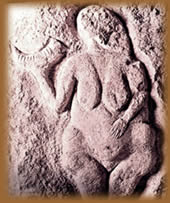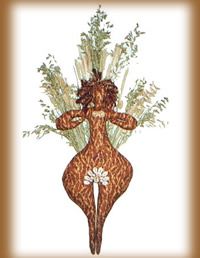
Goddess
of fertility
Dordogne, France, 20,000 BCE
Give us this day our daily bread... (Traditional prayer)
For many of us on this planet, obtaining our food is a fairly straightforward process. In recent years, however, the heart-rending images from drought-stricken countries have served as stark reminders of how tenuous life can be.
Throughout human history it has been a universal trait to seek supernatural reassurance that our needs will be answered. The image at left, dating back thousands of years, is one of the earliest representations of a deity believed responsible for ensuring human survival: in this instance a goddess whose bounteous fertility provided animals for the hunt.
*Pronounced Loo-nassa

Corn
dolly
(tarot
card by Lynn Dewart)
For the early Celtic agricultural communities, Lughnasadh was the first day of the harvest, when the fields were burgeoning with corn† and reaping would begin. Although nowadays most of us are removed from the agricultural way of life, Lughnasadh is still regarded as a harvest festival by modern day Pagans, and symbols connected with the reaping of corn—for example the offering of corn dollies—predominate in its rites.
In earlier times, the first and last stands of wheat to be cut had major significance. Grain from the first sheaf would be made into a loaf of bread; the medieval Christian festival Lammas (from Old English hlaf maesse, ‘loaf mass’), at which bread baked from the first wheat of the season was blessed, naturally came to be linked with Lughnasadh.
It was the final sheaf that was reserved for transformation into a dolly. ‘Dolly’ is a corruption of the word ‘idol’ and corn dollies were believed to represent the spirit that lives in the grain. However, freed at the moment of the harvest, there was no guarantee the spirit would return, so people may have begun the earliest corn dollies as a form of trapping this spirit, so that it would continue to ensure the renewal of the crop.
†The term ‘corn’ is a reference to the main cereal crop, e.g. in the UK it is wheat, in the US maize, in Scotland and Ireland it is oats.